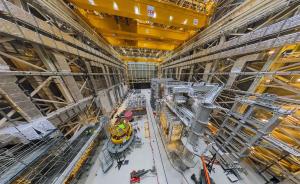The assembly theatre
Ever since it was invented almost two centuries ago, photography has tried to capture what the human eye actually sees. Despite huge progress achieved, it has never completely succeeded: human vision is not only a matter of optics but also of a complex process of visual data processing that balances light, straightens perspective and, thanks to binocular vision, enables the perception of distance and volume.
However, there is one area in which photography has improved on nature. The digital age has brought techniques that can simulate a field of vision much wider than that of the human eye—combined with virtual reality (VR) tools, "360° capture" now allows viewers to explore a scene not only from a wider perspective but also from multiple angles.
360° shots such as the one Newsline is featuring today provide a unique way to experience the ITER building site. Vast and often equipment-packed, an environment like ITER cannot be captured through a single image or even a panoramic shot.
This image, produced by ITER contractor Emmanuel Riche, enables the viewer to stand (virtually) on top of the wall that separates the Assembly Hall from the Tokamak pit and to understand how the two spaces connect. By moving the computer mouse up, down, right or left and rolling the scroll wheel backward or forward, the viewer can take in the "assembly theatre" in its totality.
Improved and refined by Riche, the 360° degree photography/VR technique provides an even more striking experience when viewed with a virtual reality headset. (If you have one, click on the third icon from the right at the bottom of the screen in the link below and the split image will morph into 3D).
The ITER Newsline will publish 360° "images of the week" on a regular basis, showcasing different areas of the worksite.
Click here to view a 360° image of the assembly theatre.


